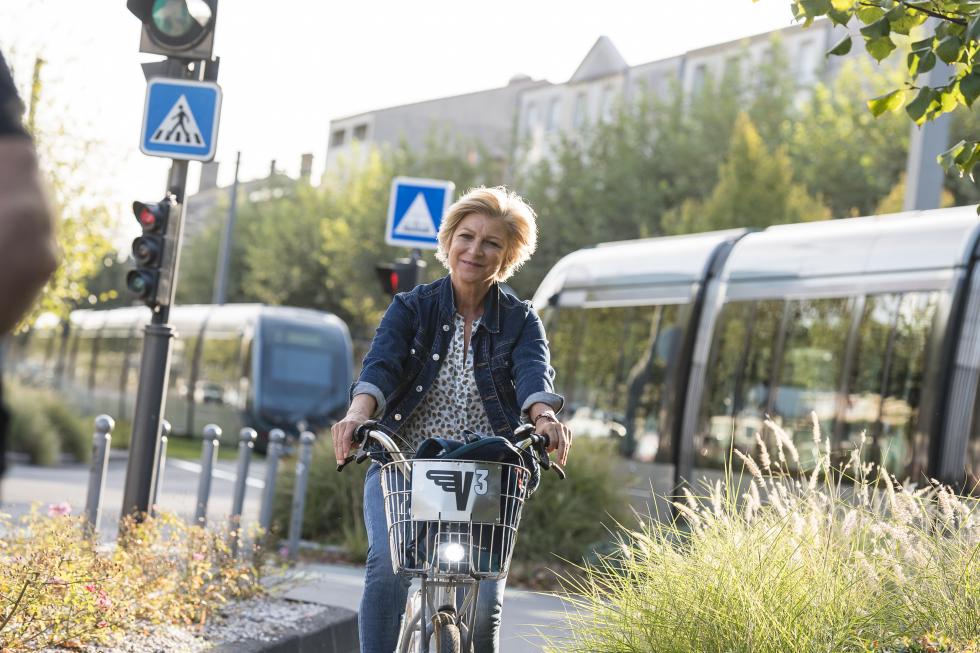
Important rules
In Greater Bordeaux, accidents involving cyclists and cars / lorries / public transport are all too common. So, please be extremely vigilant at all times, for your own safety and that of others.
Blind spots
- A blind spot is an area around a vehicle which cannot be seen by the driver.
- A lack of visibility significantly increases the risk of accidents. Blind spots, especially around large vehicles such as lorries and buses, can prevent a driver from seeing a cyclist.
- SOME ADVICE: never cycle alongside a lorry or bus. Position yourself far in front of, or behind large vehicles, never alongside them.
At night time or in the rain
- Make sure you are easily visible!
Think about lights: Every bike should have a white or yellow light at the front and a red light at the back. You should also wear a reflective vest for your own safety.
Traffic lights
- Stop at red traffic lights. You are obliged to follow the highway code and stop at red lights, just like someone driving a car.
Tram signals
- Be careful near tram tracks. Don’t forget, a tram takes 40 metres to stop. You must stop at a red light. It means a tram is approaching.
Ten tips from Vélo-Cité!
Cycle stop boxes can be found at traffic signals. The zones are in front of the regular traffic stop line. They serve several functions: they indicate the position of cyclists on the road and also mean that cyclists don’t have to breathe in vehicle exhaust fumes. Cyclists using the zone can turn left more easily and can pull away in front of traffic. If a motorised vehicle fails to respect a cycle stop box, they could receive a €35 fine.
These are one-way streets where you can legally cycle in both directions. They shorten your journey time and make the city more bicycle-friendly. The law of 30th July 2008 allowed contra-flow cycling in 30 zones. Municipalities now have 2 years to ensure their decrees and signage comply with the law.
Contra-flow cycling is already in force in the heart of Bordeaux city centre and the plan is to extend this throughout Greater Bordeaux within the next few years. And outside the city.
At junctions, cyclists must be wary of vehicles turning right. Blind spots, especially around large vehicles such as lorries and buses, can prevent a driver from seeing a cyclist. Some advice: never cycle alongside a lorry or bus. Position yourself far in front of, or behind large vehicles, never alongside them. At junctions, slow down so you check thoroughly to see if anyone is turning right.
All too often, cyclists make mistakes when a car approaches on a narrow road (of around 3 metres in width): they sometimes cycle close to parked cars to let other vehicles overtake.
This is extremely dangerous as people can open car doors unexpectedly. Other cyclists choose to skim the pavement and gutter which is equally dangerous (they could catch the edge of the pavement).
In both cases, the cyclist could be hit by a car.
Remember, the highway code states that motorised vehicles must leave a distance of 1 metre when they overtake a bike in a town (1.50m outside urban areas).
If the road is 3 metres wide, it’s obviously impossible to do this: 1 metre of distance + 2 metres of car width + 1 metre for the bike width = 4 metres.
Cyclists should therefore stay in the centre of the road for their own safety. Vehicles have to wait behind them, and shouldn’t overtake until the road is wider.
Turning left onto major roads is difficult for cyclists.
At some junctions (mainly junctions with boulevards), cyclists can turn left using a protected zone to their right. This means they can wait at the junction until the lights go green and they can turn left safely. A square sign with green symbols indicates how to use a particular junction.
In other places, left turns for cyclists are clearly marked. In Bordeaux, for example, cyclists can cross diagonally at Barrière Saint Augustin.
Bicycles are permitted in all bus lanes in Greater Bordeaux (with a few rare exceptions).
Cyclist road markings and a sign indicating “vélosautorisés” indicate that cyclists can use that lane. Buses and cyclists can use the lane when an orange light flashes.
When a bus is moving or stopping, a cyclist should always position themselves in front or behind the bus but never alongside it (and be aware of blind spots).
Make sure you’re always careful around these large vehicles when they’re turning left or right!
Greater Bordeaux has recently introduced “right turns” for cyclists meaning they can turn right on a red light. There are lots of these at junctions around the city.
The aim of this measure is to relax what is considered to be a car-centric Highway Code and encourage people to travel by bike.
At these junctions, cyclists must still give way to pedestrians, as they have priority when crossing at a green light.
You must cross tramlines directly, so taking the shortest route across.
When permitted, you can cycle on tram routes. However, you must cycle as far as possible from the actual track hollow. You should never drift onto the tracks when moving left or right.
The same advice applies to pedestrian streets and the edges of pavements. Rue Sainte Catherine is a good example of this.
When you’ve stopped at the roadside or alongside a pavement, before setting off again, you must look behind you for vehicles approaching. This means road users behind you won’t be surprised when you suddenly launch yourself back onto the road!
You must pay attention at Y-junctions. Make sure you clearly indicate which way you’re turning to avoid other road users moving into your path!
Signal with your arm to show drivers if you’re intending to turn left rather than right.







